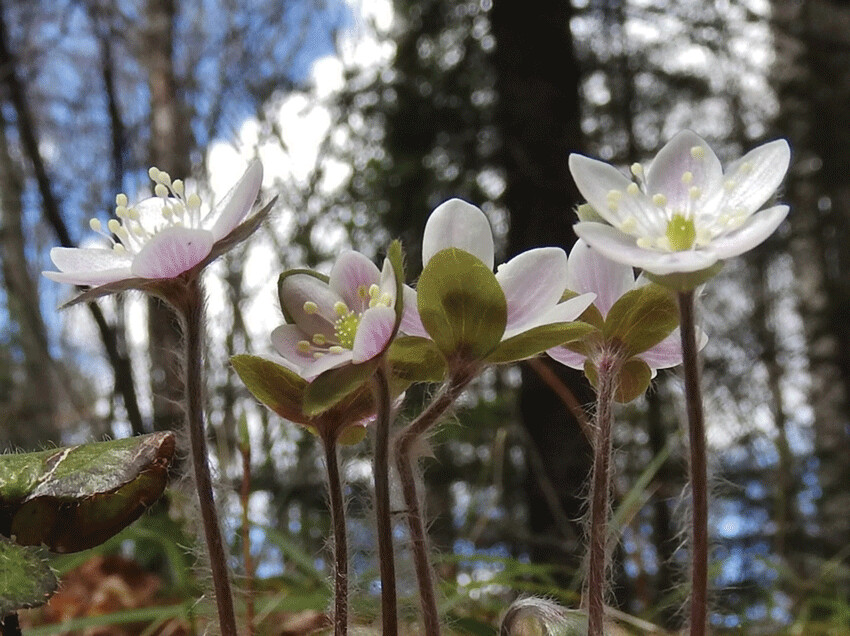Little Packets of Fatty Goodness


After you notice one, you start seeing them everywhere. As I hiked toward the Juniper Rock Overlook on the North Country Trail, a chilly breeze gusted out of the sunny blue sky. This spring has been slower than some, and I couldn’t wait to see some flowers. Not far down the trail, a cluster of pale purple hepaticas bloomed atop hairy stems.
After photographing the hepaticas, I moved on to trying to capture the tiny crimson petals thrusting out of the bud on a beaked hazelnut twig. A single leatherleaf shrub in bloom with delicate yellow flowers brought similar excitement. When I noticed the triumvirate of trillium leaves flanking a tightly furled bud, I was thrilled.
As my eyes adjusted, my mental search images honed, and the green spikes and clusters of leaves appeared everywhere. Finally, I also spotted the lovely white blossoms of spring beauties with varying amounts of pink pinstripes.
These spring ephemeral wildflowers have figured out that they can make use of the rich soil in the shady depths of deciduous forests, so long as they get a head start on the trees. In part because they only show up for such a short time each spring, they have captured many a heart.
In addition, many of these flowers have a close, symbiotic relationship with ants. You don’t see it now, but in a month or so, when they are done blooming and have gone to seed, a soap opera emerges. All the wildflowers I listed above attach a packet of fatty goodness, like a donut for ants, to the outside of their seeds. Called an elaiosome, this little bit of energy-rich lipids, amino acids, and other nutrients, shows that the way into an ant’s hill is through its stomach.
Ants carry the elaiosome, still attached to its seed, down into their hill. There the ants may feed it to their larvae or eat it themselves. The seed, which is smooth, hard, tough to hold on to, and impossible to eat, is thrown into the ants’ midden or garbage heap. Here, in a nitrogen- and phosphorus-rich environment, among moist, decaying plant matter and the bodies of dead ants, the seed has a wonderful place to grow. It is safe from birds, other insects, and even forest fires. This type of ant-assisted seed dispersal is called myrmecochory.
Myrmecochory (mur–me-co-cory) is exhibited by more than 3,000 plant species worldwide, and is present in every major biome on all continents except Antarctica. One study determined that it has evolved at least 100 separate times in 55 different plant families.
In nature, when there is success, there is often a cheater. Hepatica, a beautiful purple or white spring ephemeral flower that emerges before its leaves, is an unassuming swindler. Instead of providing a detachable treat for the ant, hepatica just covers its seed in a non-removable elaiosome with the same chemical cues as its neighbors’ true elaiosomes.
When ants take hepatica’s seeds back to the nest, the elaiosome can’t be eaten, and the chemical cues stay intact. Instead of being stripped of its packet of fatty goodness and thrown in the trash heap, the hepatica seed stimulates each ant that passes by to pick it up by the permanently perfumed handle and carry it somewhere else. Hepatica saves energy by not making a large elaiosome, and it benefits when its seeds are distributed more widely. In return for their dispersal services, the ants get nothing. Hepatica is a parasite!
If cheaters win, though, then pretty soon everyone starts cheating. For a mutualism (a symbiotic relationship where both parties benefit) to continue, it must provide appropriate rewards. Scientists have found that seeds with true, tasty, edible elaiosomes are transported by ants much more often than the cheater seeds of Hepatica and others like it. “In this situation, cheating … establishes a background against which better mutualists can display competitive superiority, thus leading…to the reinforcement of the mutualism (Pfeiffer et al, 2009).”
Such drama, on what may seem like a small scale, impacts entire ecosystems on six continents. In this northern hardwood forest, maple leaves cushioned my knees as I crouched down to get look closer at the just-opened flowers of Dutchman’s breeches. A bit of movement caught the corner of my eye, and I shifted my focus to a patch of soft moss. A tiny black ant was scrambling its way across a jungle of leaves. As my gaze widened, I noticed another ant, and then another and another, all busy with their own lives. After you notice one, you start seeing them everywhere.
Note: Portions of this article are reprinted from a 2013 Natural Connections article, which is now a chapter in Emily’s first book.
Emily’s second book, Natural Connections: Dreaming of an Elfin Skimmer, is now available to purchase at www.cablemuseum.org/books and will soon be available at your local independent bookstore, too.
For 50 years, the Cable Natural History Museum has served to connect you to the Northwoods. Come visit us in Cable, WI! Our new Curiosity Center kids’ exhibit will open May 4. Grand Opening on May 25!
